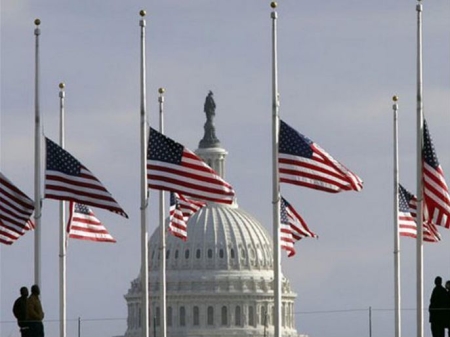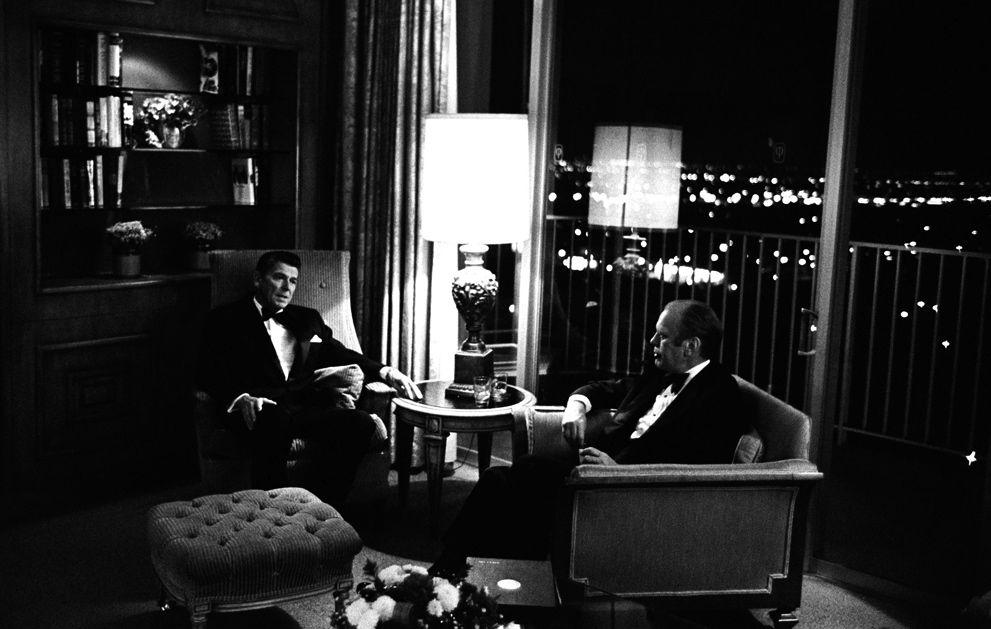Actions convey messages. Actions communicate. How one acts in regarding the U.S. flag, at different times when action is required, tells something about character — whether one was even paying attention when respect for the flag, and the ideals it portrays, was explained.

President Ford’s casket lies in the rotunda of the U.S. Capitol. New York Times photo by Todd Heisler.
Back in early 2007 I discussed some of the flag etiquette we saw at the funeral of President Gerald R. Ford. We see these things again at the funeral of President George H. W. Bush. Let’s repeat the observations.
Here are a few things you may have observed during the services for President Ford, which you may observe again at the funeral of George H. W. Bush, with minor edits:
1. On his coffin, the U.S. flag’s union will always be over President Bush’s left shoulder. This is a reversal from the usual display method for the flag; in display on a wall, the field should always be in the upper left as one observes it, the “northwest” corner (as if looking at a map); on a coffin, that would put the flag over the person’s right shoulder. Instead, on a coffin the flag is draped so the union is over the left shoulder, usually explained as being over the soldier’s heart. Also, note that a flag-draped casket should be carried foot first to the grave.
2. Since Bush is a military veteran, the flag should accompany the casket to the grave, but not into it (I believe this applies also to presidents if they did not serve, but in any case it applies to Bush). The flag will be folded in the traditional seafaring triangle fold, and presented to the Bush family before the casket is lowered into the grave.
3. When the flag is folded at the cemetery, watch how carefully the military people will work to get each fold just right. Their goal is a perfect fold, which will leave only the blue field of stars from the union showing, in a triangular fold. To get it right, the color guard (pall bearers, I presume in this case) will take its time. Occasionally the flag team will halt and unfold the flag, and refold, if the process is not proceeding just exactly right. But that is rare; the flag folding team sacrifices speed, for care. If the ceremony proceeds very quickly, I would be surprised.
4. It is unlikely that there will be any ceremonial reading during the folding of the flag. Any reading given, however, would be selected by the family. In the past couple of decades, presidential funerals have been planned out well in advance of the event. Differences between Bush’s funeral in 2018, Ford’s funeral in 2007 and Reagan’s funeral in 2004, are due to the different plans of the families, not due to any formal procedure required by U.S. law or tradition. We’re a democratic nation, and such ceremonies are not sacred writ. (I have written here before about the mistaken idea that there is an “official” flag folding ceremony with specific meaning given to each of the 13 foldings of the flag; there is no official ceremony. There is no official meaning ascribed to the folding of the flag; the triangular fold is a convenience at sea, where flags folded into the triangle will unfurl without fouling or snagging as they rise up the mast. We continue that tradition on land.)
In general, the flag will be treated respectfully. Do not expect to see a lot of flag waving during the service. When the flag is present, it will be treated soberly, with care, with special attention to getting official ceremonial details correct.
Students, Girl Scouts and Boy Scouts should pay attention.
- Associated Press photo by Lawrence Jackson. Telephoto showing some of the 50 flags surrounding the Washington Monument flying at half-mast in honor of the late President Gerald Ford, with the dome of the U.S. Capitol in the background. The Capitol is more than a mile away from the Washington Monument; compression of the images by the telephoto lens makes the dome appear much closer.
Flags fly at half staff in honor of former President Gerald Ford at the Washington Monument, with the U.S. Capitol in the background, on Dec. 27, 2006. Ford will lie in state in the Capitol before burial in Grand Rapids, Mich. Credit: AP Photo/Lawrence Jackson
Minor update: The Coeur d’Alene, Idaho, Press has an informative article about flag etiquette in this situation, here.
See also:
- Flags at half-mast to honor President Ford
- News coverage of “new” flag ceremony for Air Force
- Fisking a flag fold flogging
- Flag ceremony update
- Flag ceremony update, 2
2018 update: President George H. W. Bush’s casket lies in state, in the rotunda of the U.S. Capitol, on the catafalk originally constructed to hold the casket of President Abraham Lincoln.





 Posted by Ed Darrell
Posted by Ed Darrell 















